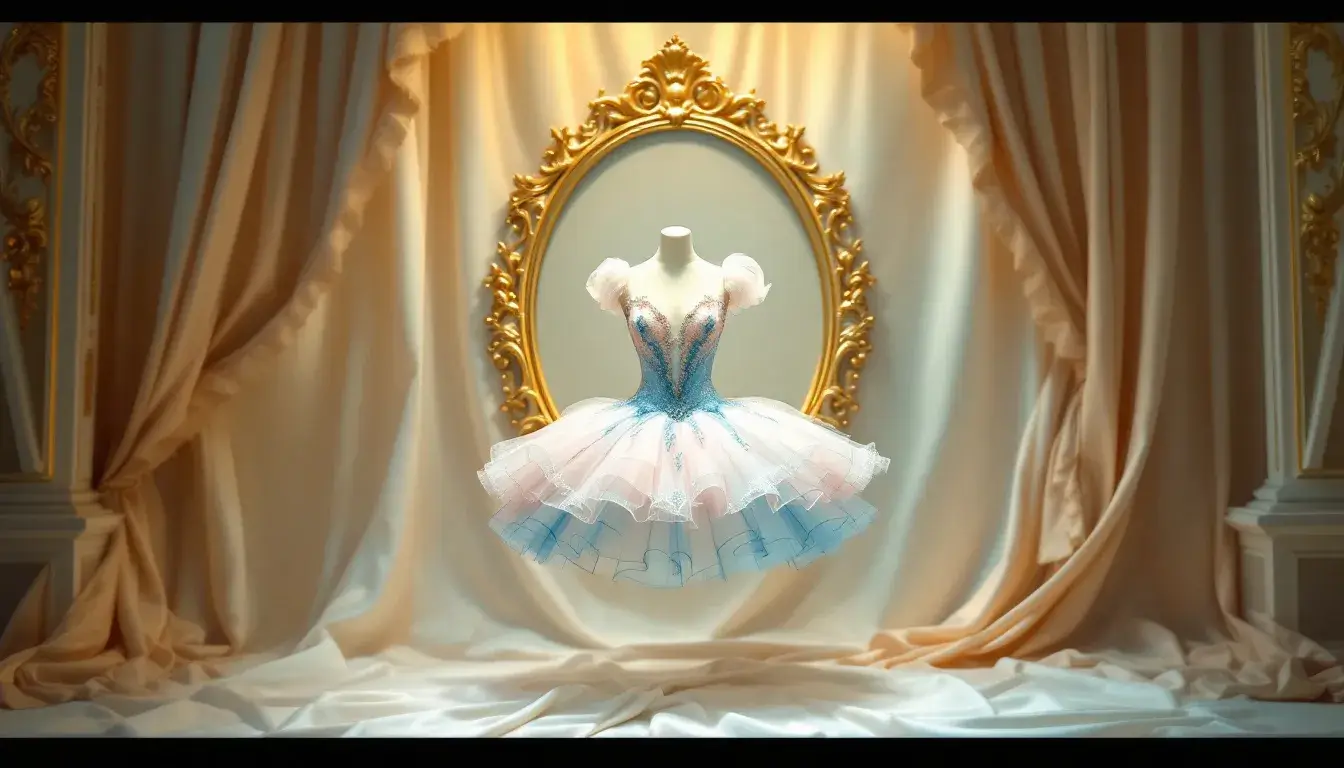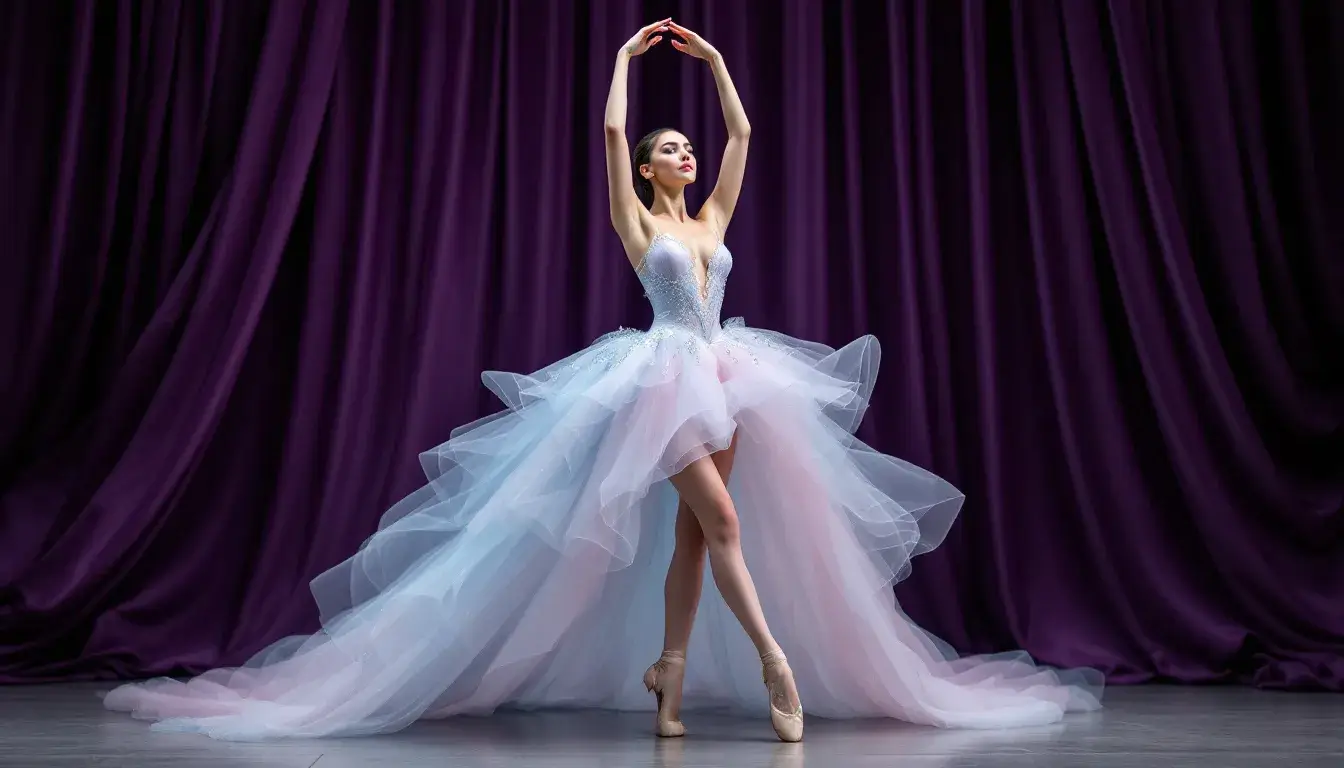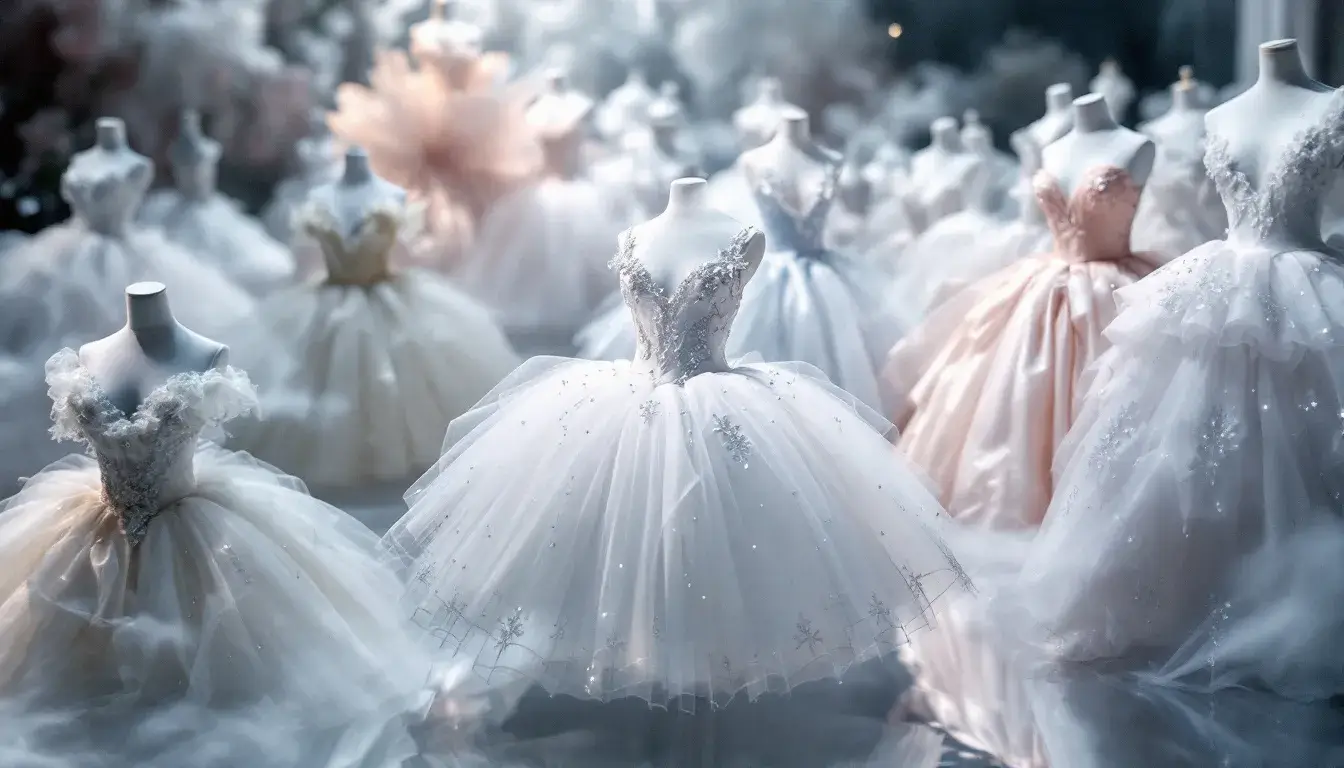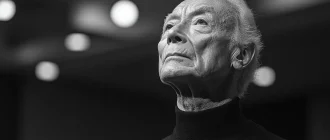What is a Balanchine tutu, or what is it? A Balanchine tutu is a ballet costume designed by George Balanchine and Barbara Karinska. It’s shorter, softer, and lacks a wired hoop. These features make it lighter and more flexible than traditional tutus, aligning with the attributes of modern tutus, which prioritize dancer mobility and comfort. This design complements Balanchine’s dynamic choreography.
Key Takeaways
- The Balanchine tutu, developed by George Balanchine and Barbara Karinska, features a shorter length, softer tulle, and no wired hoop, enhancing dancer mobility and expression.
- Ideal for neoclassical and contemporary ballet, the Balanchine tutu supports dynamic choreography through its flexible design and fluidity.
- Key differences between Balanchine and traditional tutus include fewer layers, a modern silhouette, and greater emphasis on functional elegance, reflecting the evolution of ballet costumes. Unlike the ornate performance tutus, a practice tutu is designed for rehearsals. It provides dancers with a practical garment that helps them adjust to the weight and structure of performance tutus while improving spatial awareness during group choreography.
Art de Podcast
| Aspect | Description |
|---|---|
| Origin | Designed for George Balanchine’s neoclassical ballets in the mid-20th century. |
| Design | Short and pancake-like, it lacks layers of tulle that extend far from the body. |
| Purpose | Highlights clean lines of dancers and complements intricate footwork. |
| Material | It is usually made of light materials like tulle and muslin for easy movement. |
| Length | It ends just above the hip line, exposing more leg to emphasize technical precision. |
| Support | Minimal boning or hooping compared to traditional romantic or classical tutus. |
| Silhouette | Sleek and compact, offering a modern aesthetic. |
| Key Feature | Simplicity with a focus on utility rather than ornate decoration. |
| Notable Appearances | Frequently seen in Balanchine’s ballets, such as “Jewels” and “Serenade.” |
| Choreographic Role | Designed to harmonize with Balanchine’s abstract, plotless choreography. |
| Comparison | It is more minimalist than romantic tutus and less structured than classical tutus. |
| Popularity | Widely adopted for neoclassical and contemporary ballets worldwide. |
The tutu, a staple of classical ballet, has a rich and fascinating history that spans centuries. From its humble beginnings in the Romantic era to its modern-day interpretations, the tutu has become a symbol of elegance, beauty, and technical mastery for many dancers.
The Origins of the Balanchine Tutu

The mid-20th century has brought significant changes to the ballet world, with George Balanchine at the forefront of these innovations. Seeking a tutu that would not impede a dancer’s movements, Balanchine collaborated with costume designer Barbara Karinska to develop what would become known as the powder puff tutu.
Karinska’s expertise ensured a functional and aesthetically pleasing design, granting female dancers greater freedom and an elegant silhouette.
Balanchine aimed to create a tutu that aligned with his dynamic choreography, emphasizing athleticism and expressiveness. This new design allowed ballerinas to showcase their skills more effectively, influencing contemporary ballet and becoming a staple in performances around the world.
Characteristics of the Balanchine Tutu

The Balanchine tutu is renowned for its unique features, which set it apart from traditional tutus. Its design includes a shorter length, softer tulle, and the absence of a wired hoop, all of which contribute to a lighter and more flexible costume that enhances a dancer’s movements.
Each of these characteristics plays a crucial role in the overall functionality and aesthetic of the tutu.
Shorter Length
A distinctive feature of the Balanchine tutu is its shorter length. Unlike traditional tutus, which often reach the knee or lower, the Balanchine tutu is cut to mid-thigh, allowing the dancer’s legs to be more visible. This enhances the visual impact of their movements, allowing for more expressive footwork and leg extensions.
This shorter skirt contributes to a modern and streamlined appearance, reflecting evolving dance styles in ballet. This design choice highlights the agility and grace of the dancers, making every leap and turn more pronounced and captivating for the audience.
Softer Tulle
The use of softer tulle is another hallmark of the Balanchine tutu. Unlike the stiff tulle sewn in classical tutus, which maintains the iconic flatness and structure, the softer tulle in Balanchine tutus provides a more fluid and flexible structure. This allows dancers to move more freely and execute a wider range of movements, enhancing the overall expressiveness of their performance.
Multiple layers of soft tulle also add a delicate and romantic quality to the tutu’s visual appeal. This design choice creates an ethereal effect, making the movements of shorter tutus appear more seamless and graceful, which is essential in conveying the elegance of ballet.
Lack of Wired Hoop
The absence of a wired hoop differentiates the Balanchine tutu from traditional designs. Without the rigid structure of a wired hoop, the tutu maintains a puffier and more natural shape, allowing for greater freedom of movement. This design choice significantly enhances the dancer’s ability to perform complex and athletic movements without restriction.
I am omitting the wired hoop, which results in a visually appealing and highly functional tutu that perfectly blends form and flexibility. This feature is particularly beneficial in contemporary performances, where dynamic and expressive choreography is paramount.
Balanchine Tutu in Performance

The Balanchine tutu’s unique design suits it for specific types of ballet performances, notably neoclassical and contemporary ballets. These styles benefit from the tutu’s flexibility and dynamic appearance, allowing dancers to deliver more athletic and expressive performances.
Let’s explore how the Balanchine tutu enhances these distinct ballet styles.
Neoclassical Ballets
Neoclassical ballet, characterized by its clean lines and minimalist elegance, perfectly matches the Balanchine tutu. The softer tulle used in these tutus creates a graceful and flowing silhouette, complementing the fluid movements typical of neoclassical choreography. This dynamic look is essential for maintaining the aesthetic integrity of such performances.
The Balanchine tutu supports fluid and expressive movements in neoclassical ballets, enhancing visual appeal. The classical tutu top’s design emphasizes the dancer’s lines and movements, making each gesture more pronounced and impactful.
Contemporary Ballets
The Balanchine tutu offers unparalleled versatility in contemporary ballets. Its flexible design allows dancers to explore innovative movements and expressions, perfectly aligning with the experimental nature of contemporary choreography. This adaptability makes the Balanchine tutu a popular choice for modern performances.
The softer tulle and lack of a wired hoop enable the tutu and skirt to move seamlessly with the dancer, enhancing the overall visual and emotional impact of ballet and contemporary ballets. This allows for a more immersive and engaging performance experience for the dancers and the audience.
Comparison with Other Tutu Styles

It is helpful to compare the Balanchine tutu with other traditional tutu styles, such as classical, romantic, and pancake tutus, to fully appreciate it. Each romantic tutu style has distinct characteristics that influence its appearance and functionality.
Understanding these differences can provide deeper insights into the evolution of ballet costumes.
Classical Tutu vs. Balanchine Tutu
The classical tutu is known for its short, stiff tutu structure that projects horizontally from the hips, typically consisting of tulle. While visually striking, this design limits the dancer’s range of motion due to its rigidity.
In contrast, the Balanchine tutu features a short skirt with fewer layers—usually 6 or 7—each slightly longer than the above. This creates a more flexible and dynamic silhouette. The softer and more flexible design allows for greater freedom of movement, making the Balanchine tutu more suitable for modern, athletic dance performances.
The contrast between the two styles highlights the evolution of ballet costumes from rigid and decorative to functional and expressive.
Romantic Tutu vs. Balanchine Tutu
The romantic tutu, popularized during the Romantic era of ballet, is characterized by its inverted bell silhouette that falls just below the knee. This design creates a flowing and graceful appearance, emphasizing the ethereal quality of romantic ballets, romantic-style tutu skirts, and Sleeping Beauty romantic tutus.
Conversely, the shorter Balanchine tutu, a bell-shaped romantic tutu, enhances the visibility of the dancer’s legs and allows for more expressive movements. While the romantic tutu provides a soft and dreamy aesthetic, the Balanchine tutu adopts a more angular and modern look, reflecting the changing tastes and techniques of contemporary ballet.
This comparison underscores the diverse stylistic approaches within the art form.
Pancake Tutu vs. Balanchine Tutu
The pancake tutu is distinguished by its flat, horizontal silhouette, achieved through stiff tulle and a steel bone coated in plastic for support. This design creates a voluminous and playful appearance, but can restrict a dancer’s movement due to its rigidity.
In contrast, the platter tutu, with its flat top layer extending horizontally from the dancer’s waist, is often used in classical ballets like ‘Don Quixote’ and ‘Sleeping Beauty’ to symbolize grace and purity. The Balanchine platter tutu’s softer construction allows for greater flexibility and fluidity.
The pancake tutu’s structure is ideal for classical performances that require a dramatic, structured look. However, the Balanchine tutu offers a better balance of form and function for more dynamic and expressive performances.
Materials and Craftsmanship
The craftsmanship behind the Balanchine tutu is a testament to the skill and artistry that go into ballet costume design. This section will explore the materials and techniques used to create these iconic tutus, focusing on the layers of tulle and decorative elements that contribute to their distinctive look.
Layers of Tulle
The Balanchine tutu features multiple layers of soft tulle, essential for its structure and movement. These layers are carefully arranged to create a delicate yet dynamic shape, allowing the tutu to flow naturally with the dancer’s movements. This use of soft tulle distinguishes the Balanchine tutu from more rigid traditional styles.
Combining multiple layers and soft tulle results in an elegant and functional tutu. This design enhances the performance by providing a fluid and graceful appearance, essential for conveying the beauty and artistry of ballet.
Decorative Elements
While the Balanchine tutu embraces a minimalist approach to decoration, subtle enhancements can significantly impact its overall appearance. Decorative elements such as embroidery, beads, sequins, trims, and feathers are carefully chosen to complement the tutu’s design without overshadowing it.
These elements are applied precisely to enhance the ballet tutu’s beauty and movement, ensuring it remains a harmonious part of the ballet performance. The balance between functionality and aesthetics of the bell tutu is crucial in creating a costume that supports the dancer’s artistry.
Care and Maintenance of Balanchine Tutus
Proper care and maintenance are essential for preserving costumes and the quality and longevity of Balanchine tutus. This section offers practical tips on cleaning and storing these delicate costumes to keep them pristine.
Cleaning Tips
Due to the delicate fabric, Balanchine tutus require special attention when cleaning. Hand washing with a gentle detergent is recommended to avoid damaging the tulle and other materials. Spot cleaning with cold water and a gentle brush can help keep the tutu clean without subjecting it to unnecessary wear.
After washing, it’s advisable to hang the tutu upside down to refresh its shape and prevent creases. These careful cleaning methods help preserve the tutu’s delicate structure and ensure it remains performance-ready.
Storage Solutions
Proper storage is crucial for maintaining the shape and quality of a Balanchine tutu. It should be stored flat or hung in a breathable garment bag to avoid crushing the delicate fabric. This helps preserve the tutu’s structure and prevents damage from prolonged compression.
Regular inspections and gentle cleaning are also essential to keep the tutu in optimal condition. By following these storage solutions, dancers can ensure their Balanchine tutus remain beautiful and functional for mature performances.
Where to Buy or Rent a Balanchine Tutu

Several reputable sources are available for purchasing or renting a Balanchine tutu. Dancewear shops, specialized online retailers, and custom designers offer a range of options to suit individual needs and preferences. Purchasing from reputable vendors ensures quality and a proper fit, which are essential for performance.
Additionally, ballet companies and schools often provide rental opportunities for high-quality Balanchine tutus. For example, the New York City Ballet has a dedicated costume shop that designs and maintains tutus, serving as a valuable resource for dancers.
These options make it accessible for dancers at all levels to experience the elegance and functionality of a Balanchine tutu.
Summary
The Balanchine tutu represents a significant evolution in ballet costume design. It combines aesthetics with functionality to enhance the dancer’s performance. Its shorter length, softer tulle, and lack of a wired hoop allow greater freedom of movement, making it a preferred choice for neoclassical and contemporary ballets.
Understanding the unique characteristics, materials, and craftsmanship of the Balanchine tutu provides valuable insights into this iconic costume. Whether you’re a dancer, a ballet enthusiast, or simply curious about the art form, the Balanchine tutu offers a fascinating glimpse into the world of ballet.
Frequently Asked Questions
What makes the Balanchine tutu different from other tutu styles?
The Balanchine tutu is distinctive due to its shorter length, softer tulle, and absence of a wired hoop. These features enhance movement and create a more dynamic look, encouraging greater freedom for the dancer.
Why did George Balanchine create this style of tutu?
George Balanchine created this new tutu style to enhance a dancer’s mobility and expression, ensuring that the outfit would not hinder athleticism in performance.
How should a Balanchine tutu be cleaned?
Balanchine tutus should be gently hand-washed with mild detergent and spot-cleaned with cold water when needed. After cleaning, hang the tutu upside down to maintain its shape.
Where can I buy or rent a Balanchine tutu?
You can buy or rent a Balanchine tutu from reputable dancewear shops, specialized online retailers, or directly through ballet companies and schools that provide rental options for practice tutu.
What types of performances are best suited for the Balanchine tutu?
The Balanchine tutu is best suited for neoclassical and contemporary ballets, as its flexible design enhances the dancer’s movements. This makes skirts an excellent choice for performances that emphasize athleticism and artistry.







